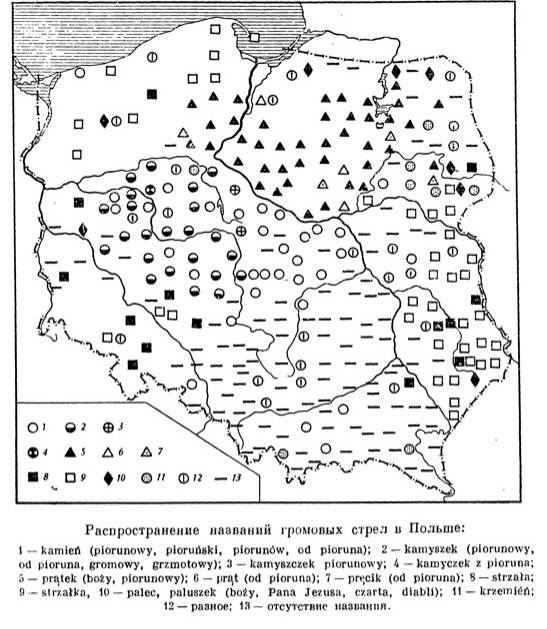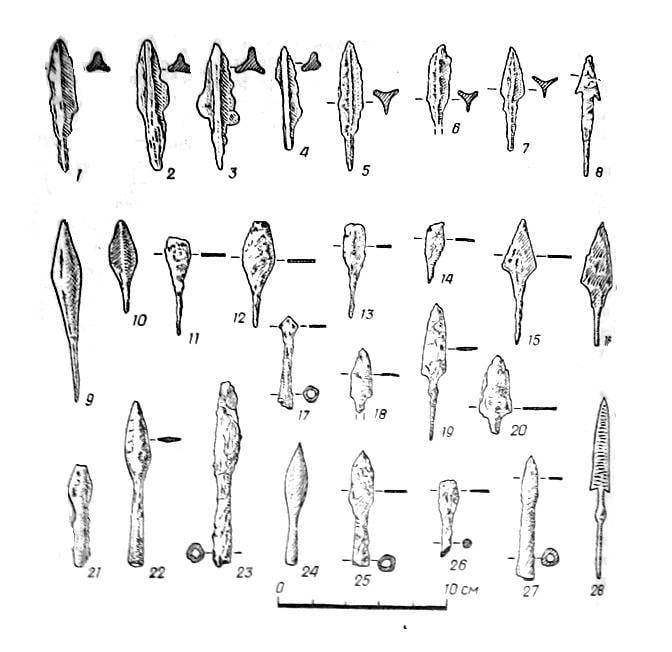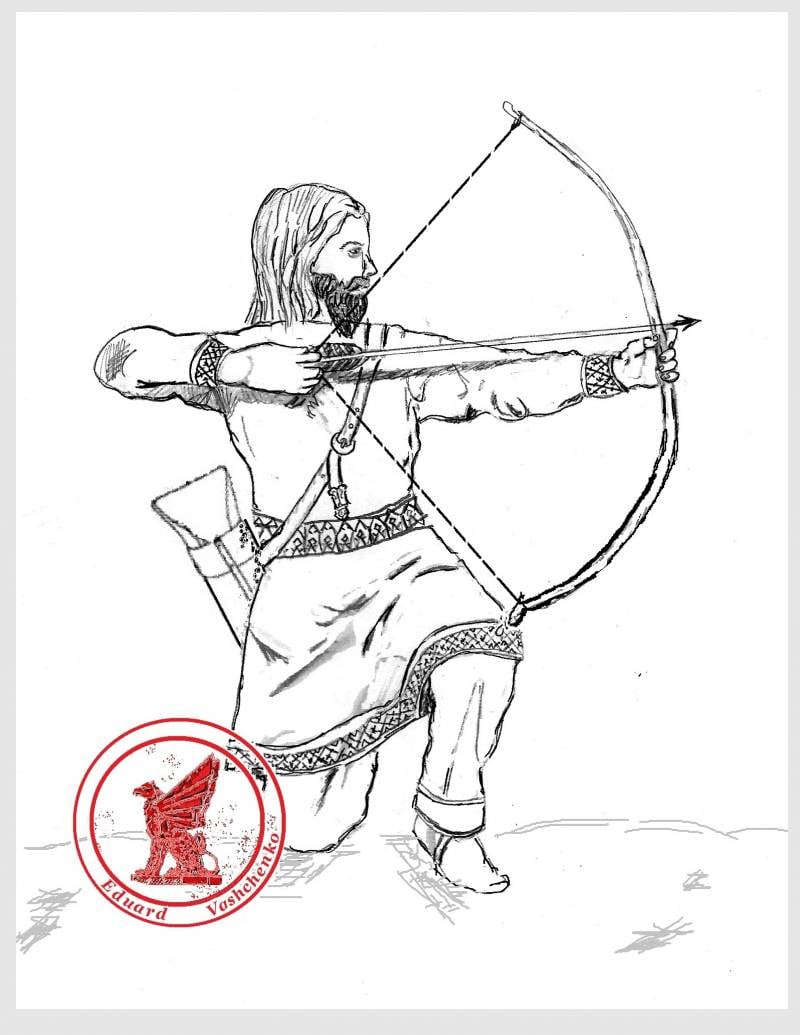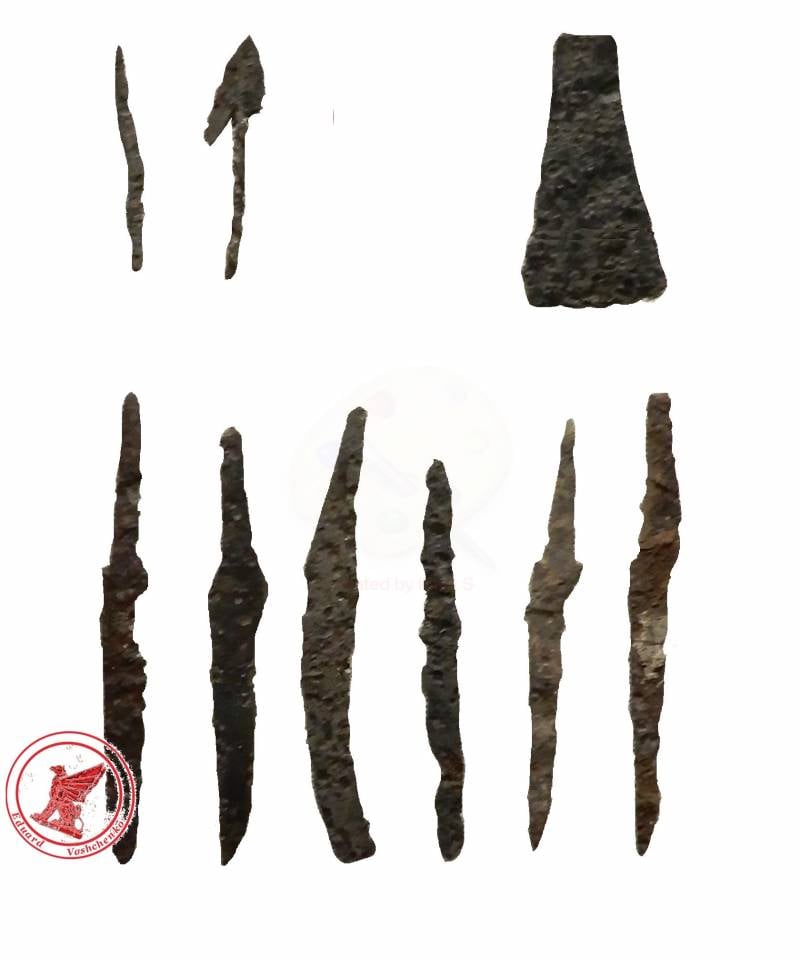Arrows of Perun. Armament of the Slavs of the VI-VIII centuries.
This article continues the cycle about Slavic weapons early period on "VO". It provides a comprehensive analysis not only of this type of weapon, but also its connection with the mental ideas of the ancient Slavs.
Military Byzantine theorists reported that the bow and arrow were far from the main weapon of the early Slavs, in contrast to the spear. But when describing the hostilities, the sources inform us about the constant use of the bow by the Slavs.
Perun, his bow and arrows
The spear, which was actively used by the early Slavs, had a sacred meaning for many ethnic groups, but not for the Slavs. But arrows and a bow were directly associated with the god of thunder, whose attributes were these weapons.
The etymology of the term "arrow" remains open. According to M. Vasmer's "Dictionary", it has a pre-European origin. And among Bulgarians and Rezians, Slovenes from Italian Friul, the rainbow was considered God's bow. In Slavic languages, the common noun perun, motivated by the verb perti, means "the one who hits, strikes."
Other weapons were also associated with Perun.
Perun (like another famous thunderer, Zeus) went through a series of steps. And it seriously changed at different stages of the development of the tribal society, which is more or less clearly outlined on the basis of the analysis of ancient Greek mythology. In relation to the Slavic god the Thunderer, we do not have such information in historical sources, but we have data on different types of his weapons.
These types of weapons must be considered from the point of view of the evolution of the Proto-Slavic and early Slavic society and its views on the world around them, since they could not be used all together and at once. Simply put, what weapon prevailed or was of great importance for the tribe, the supreme deity was endowed with such weapons.
Therefore, the sword, for example, did not become the weapon of the supreme deity during the period when the Slavs appeared in the historical arena in the XNUMXth-XNUMXth centuries. due to the fact that such a weapon was practically inaccessible to them, as will be discussed in the next article. The sword could not in any way be associated with the weapon of the god.
Perun went through different stages of development along with the changing ideas of the ancient Slavs about the surrounding living and inanimate world. (A.F. Losev) Evolution went from the god of lightning, through the god who controls thunder and lightning, and the god of the raincoat, as a key god, influencing the agricultural cycle, to the god of war of the period of potestary society and the end of the tribal community. And the weapon that the lightning god used changed along with the development of the stages of the tribal system.
The origins of the worship of the Thunderer in the "cult of nature", characteristic of gatherers and hunters, where originally Perun
(H. Lovmyansky)
Perhaps that is why at the first stage his weapon was stone, associated with a stone hammer. In this regard, it is important that the etymology of the origin of the word "lightning" is built hypothetically, and is associated with "hammer". In Latvian it was called "Perun's hammer". There is a visible similarity with the "hammer of Thor" - "mjollnir" from the "Elder Edda", which is directly related to lightning. The sources do not find data on hammers as Slavic weapons. Although there is no such information about the use of hammers among the Germans, except for amulets of the Viking Age - the "hammers of Thor" or the sculpture of Thor with a hammer in his hand, described by Snorri Sturlusson.
But it is quite possible that the proto-Slavs also passed the stage of such weapons as stone hammers. In Belarusian fairy tales, Perun beats a snake with his weapon and stones. This weapon was not reflected in written sources that record the Slavs at a later time, when they ended up on the borders of the Byzantine Empire.
And in this, second period, the supreme deity - only
as Procopius of Caesarea wrote about him.
And there is no lightning without thunder. In this situation, we are interested in the connection of this deity with weapons. In this connection, the information of Ambassador Herberstein, who in the XNUMXth century, according to the Novgorodians, described the appearance of Perun in his sanctuary near Novgorod in Peryn during the pagan period, seems to be very important to us:
On the spot where the idol stood, a monastery was built, which still retained its name from it: "Perun Monastery".
The idol had the appearance of a man, and in his hands he held a flint that looked like a thunderous arrow or beam. "
In folklore, there is also evidence of the connection of the god of thunder with arrows or thunder, like the arrows of a god. It should be emphasized that etymologically "thunder" does not carry any other load than the generally accepted one today: to rattle, to make noise.
Herberstein's information and folklore make it possible to assert that the most important weapon of Perun was arrows during the period of the tribal system, on which the early Slavs of the XNUMXth-XNUMXth centuries were also located. and Eastern Slavs in the X century.

Thunderbolt Map
For a long time, various Slavic peoples have called and call Perun's arrows belemnites, fossilized remains of extinct cephalopods, which outwardly resemble a hollow arrowhead, "Perun's arrows", as well as fragments of meteorites.
The designation "arrows of the thunderer" under one or another name is found throughout the territory of the Slavs. These "arrows" were widely used as healing stones among the Slavs, and were inherited. (Ivanov Vch. V., Toporov V.N.)
What brings stone weapons and arrows together, like the weapon of a thunderer?
At the same time, we have information about the sacred nature of arrows.
So the shooting of prisoners with "dews" from bows, described by the Byzantine author - the successor of Theophanes, is interpreted not just as an execution, but as a rite of human sacrifice.
This event took place during the campaign of Prince Igor in 944 against Constantinople. During the sacrifices on the island of St. George, during the march from Kiev to Constantinople. Around the oak - the tree of the thunderer, the Russians stuck arrows into the ground.
After the stones, it was the bow and arrows that became the next weapon of the Thunderer God.
The emergence of "new weapons" undoubtedly testifies to the next stage in the development of ancient Slavic society, evolution in industrial relations and world outlook. All these moments were related. A step in mental representations, which undoubtedly stemmed from economic activity, where the bow was both a tool of labor and a weapon.
Herberstein's information and folklore make it possible to assert that the most important weapon of Perun was arrows during the tribal system. The building, on which the early Slavs of the XNUMXth-XNUMXth centuries were located. and Eastern Slavs in the X century.
Therefore, arrows remained the main weapon of Perun throughout the entire period of his worship. Although he also had a club or a club, the Novgorod clubs of Perun were destroyed only in the XNUMXth century. But the hypostasis of Perun, Svyatovid, was already in the X-XI centuries among the Lyutichs (Western Slavs). dressed in armor and a helmet. Among the Western Slavs, potestary structures are formed, and squads appear. And along with this, the supreme deity also receives a new weapon.
Which undoubtedly indicates a new stage in the development of society.
Later in folklore, when the bearers of the attributes of the god of thunder (for example, Elijah the Prophet) were mentioned, arrows were replaced by bullets. And this, we repeat, only emphasizes the evolution of the deity's weaponry in relation to the mentality of different periods.
The close connection of the god of lightning with the mass weapons of the early Slavs is obvious.
The early Slavs endowed the supreme deity with the same weapons that they themselves used. The god of thunder and rain (the most important agricultural god of the early Slavs) was armed with a bow and arrow. To him, as reported by Procopius of Caesarea, oxen were sacrificed.
Ethnographers testify to the rituals (which have survived to this day in different countries among the Slavs) associated with worship and offerings to the hypostases of Perun. Its significance in the agricultural cycle is obvious and indisputable: the working life of a farmer is subject to constant threats - the elements.
Byzantine writers about the bow and arrows of the Slavs
Mauritius Stratig in the VI century. pointed to simple, small-sized Slavic bows. When firing from which, arrows soaked in poison were used to compensate for the weak impact force.
At a similar stage of development, the ancient Greeks, who used simple bows, also did with their arrows. Hercules himself, the son of the thunderer Zeus, shot poisoned arrows. Hence the term "toxic" associated with the Greek name of onion - toxos. Shooting from a technologically imperfect bow was compensated for by poison. First - on the hunt, and then - in the war.
In an attempt to challenge the "injustice of history" in popular literature, groundless evidence is presented that the Slavs nevertheless successfully used the complex bow they had mastered almost since the time of the "Scythian plowmen". At the same time, forgetting that the use of one or another weapon is directly related to the formation of the worldview, environment and the level of production of one or another ethnic group during the tribal formation.
But some of the Germans did not use the bow at all. Although there are many archaeological finds of German arrowheads.
The Goths mastered it only in the 552th century, when they defended their own state in Italy from Byzantium. This often came out sideways to them, as in the battle of Tagin, in the summer of 553, when the Romans literally shot the cavalry attack of the Goths. Also in the battle of XNUMX on the Kasulin River near the town of Tannet (not far from Capua), when, repeating Hannibal's maneuver at Cannes, the Byzantine horse-drawn arrows from the flanks shot the infantry of the Alemans and Franks.
Despite the fact that the author of the "Strategy" of the late XNUMXth - early XNUMXth centuries. pointed to the secondary nature of the bow for the Slavs, it is difficult to agree with this. In economic activities and hunting, he could not help but be used.
In military affairs, the bow begins to play an important role when the Slavs, from captures from behind shelters and ambushes, move on to attacks on settlements. It is clear that it is extremely difficult to throw spears to the top of the walls. The well-aimed Slav Svarun threw a spear not up, but down - at the "turtle" of the Persians. The same cannot be said about arrows.
Already in the middle of the VI century. the Slavs took the first large city of Toper, while they knocked down the townspeople from the walls
During clashes with the Byzantine army, the Slavs actively used archery. In one of the skirmishes, the Slavs fired arrows at the commander Tatimer, wounding him. No matter how weak the bow is, it still surpasses the throwing javelin in terms of combat range, especially during a siege, not to mention the rate of fire and the amount of ammunition. Two or three throwing spears against, for example, forty arrows. Forty arrows, according to Byzantine tactics, should have been a warrior-shooter.
In 615 (616), the Slavs, when they took Salona in Dalmatia, threw it then
The attack was carried out from a hill. During the next siege of Thessalonica around 618, the Slavs
as a cloud carrying hail, so [the barbarians] closed the vault of heaven with flying arrows and stones. "
The same situation arises during the siege of Thessaloniki in the 670s:
"Rain of arrows", "arrows flying like a rain-bearing cloud" is not the will and weapon of God?
God helping to overcome. And a visible confirmation of his support.
Archeology about the bow and arrow of the Slavs
Mauritius Stratig's opposition to bows that are easy to manufacture and complex bows of nomads and Romans needs to be clarified.
Compound bows were most often used in horse battles, in which the Slavs practically did not participate. Even if we assume that in Italy the Antes served not in the infantry, but in the Roman cavalry, then, most likely, they would have used the bow of the nomads or the Romans.
The details of a composite bow found in Khitsy (Gadyachensky district, Poltava region, Ukraine) can confirm this version. But they may also indicate that this bone patch just somehow got to this Slavic settlement of the Penkovo archaeological culture.
Of course, the Slavs could shoot from a complex bow that somehow got to them. But its mass use is out of the question. (Kazansky M.M., Kozak D.N.).
But a simple bow was easy to make, and was used in everyday life. In war (with its massive use), it ensured success for the Slavs.
Let us return once more to the sequence of capturing Mr. Topper.
At first, the Slavs lured out the garrison, which, having fallen into an ambush, was destroyed. Then they dropped a cloud of arrows on the walls of the city, using, among other things, the hills, from where it was much more convenient to shoot. The townspeople (ordinary inhabitants) could not oppose anything to this. And they either fled from the walls, or were "swept away" by the shooting. And the city was taken.
Given the advantage of the Slavs in numbers, the use of such weapons was relevant and ensured victory.
If the bows of the ancient Slavs were not found at all, then with arrows (more precisely, with arrowheads) things are somewhat better. However, there is not much material.
To date, several modern studies have been devoted to their codification.
M.M. Kazansky in its catalog has 41 arrowheads. While A.S. Polyakov - 63. Shuvalov believes that Kazansky did not take into account 10 more arrowheads from the territory of Wallachia and Moldavia.
The finds can be divided into three types: three-bladed, double-winged (double-winged), and leaf-shaped.
The question of the ethnicity of the arrowheads remains open. The leaf type has no clear ethnic correspondence. A dispute arose around the three-bladed tips. M.M. Kazansky attributed the three-bladed arrows to the Slavic type, and P.V. Shuvalov believes that these are exactly the arrows of the enemies.

Finds of arrowheads of the XNUMXth – XNUMXth centuries. Winter. Western Volyn. Ukraine.
Finds of these arrowheads are found throughout Eastern Europe among bearers of different archaeological cultures, not only nomads. But this does not mean their widespread use by the local population. In our case, the ancient Slavs.
In the interfluve of the Dnieper and the Neman, where the early Baltic tribes were located, 20 such arrowheads were found during this period. In Lithuania, in the Plinkaigale burial ground, two arrowheads were found in two graves with which men were killed. They became the "reason for the funeral." That is, the arrows did not belong to the local population, but to those who attacked them. (Kazakevichus V.)
The Slavs may well have used such arrowheads as a by-product after the attacks of the nomads. A “product” that has “migrated” in different directions. And there is nothing to indicate the fact that only a complex bow had to be used to use arrows with such a tip.
The above data confirm the reports of written sources that the early Slavs used a small wooden bow.
Double-spiked or double-winged socketed tips are correlated with both the Germans and the Slavs. A. Panikarsky studied the finds of such arrowheads in detail. Such an arrow had a serious penetrating power, as was shown by an experiment conducted in England in 2006 with an English bow and similar arrows.
But P.V. Shuvalov believes that only one type of arrow is suitable for small Slavic bows. And it is represented by the only find from the settlement of Odaya (Moldavia) around the 4,5th century. It is a petiole tip with a flat rhombic cross-section nib, tapering to the point, XNUMX cm long.
Due to the fact that the blacksmith centers among the Slavs, according to archeology, do not appear earlier than the XNUMXth century, then (contrary to written evidence) the question remains how the Slavic blacksmiths provided their tribes with the proper number of arrowheads.
Perhaps the lack of an iron tip was compensated by a bone one? Or just sharpened tips, smeared with poison?
Summing up, we can say that the bow and arrow occupied an important place, both in economic activity and in war. Despite the fact that the written sources do not pay due attention to them, the analysis of the development of the tribal mentality testifies to the enormous practical and semantic significance that the Slavs attached to it.
The Slavs used arrowheads, both borrowed directly and copied from neighbors, compensating for the small impact force of a simple bow by using poison.
To be continued ...
Sources and literature:
Alekseev S.V. Great resettlement of the Slavs. 627–679 M., 2015.
Ivanov Vch. V., Toporov V.N. Research in the field of Slavic antiquities. M., 1974.
Ivanov I. The Cult of Perun among the South Slavs. M., 2005.
Kazakeyavichus V. Weapons of the Baltic tribes of the II-VIII centuries. on the territory of Lithuania. Vilnius. 1988.
Lovmyanskiy G. Religion of the Slavs and its decline (VI-XII). Translation by M.V. Kovalkova. SPb., 2003.
Losev B.A. The mythology of the Greeks and Romans. M., 1996.
Trubachev O.N. Ethnogenesis and culture of the ancient Slavs. M., 2003.
Thomas Splitsky “History of the Archbishops of Salons and Split” Translation, introductory article and comments by OA Akimova. M., 1997.
Froyanov I. Ya. Ancient Russia. M. – SPb., 1995.
Shuvalov P.V. Weapons of the early Slavs // "Cultural transformations and mutual influences in the Dnieper region at the end of Roman time and in the early Middle Ages", 2004. Volume 11. Proceedings of the Institute for the History of Material Culture. SPb., 2004.
Etymological Dictionary of Slavic Languages. Proto-Slavic lexical fund. Edited by O.N. Trubachev. Issue 20.M., 1994.
Kazanski M. L'armement Slave du haut Moyen-Age (Ve-VII-e siecles). A propos des chefs militaries et des guerriers professionnels chez les anciens Slavs // Pfehled vyzkumu. No. 39 (1995-1996). Brno.
- Vashchenko E., Ph.D.
- "The spear of fate" of the ancient Slavs of the XNUMXth-XNUMXth centuriesSlavs of the VI-VIII centuries. With shield?
How the ancient Slavs fought
The siege of the Slavs in the VI-VII centuries
How the ancient Slavs took the city
As the early Slavs actually fought
Was the squad among the early Slavs?
The clan and military organization of the early Slavs of the VI — VIII centuries
Slavs and the First Bulgarian Kingdom in the VII-VIII centuries
The origin of the Slavs
Slavs and the beginning of the Great Migration
Slavs and Avars in the VI century
Slavs on the Danube in the VI century
Slavs, Avars and Byzantium. The beginning of the VII century
Slavs on the threshold of statehood
The first state of the Slavs



Information